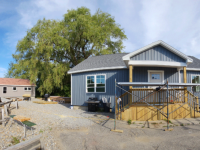The french fry lamp that heals
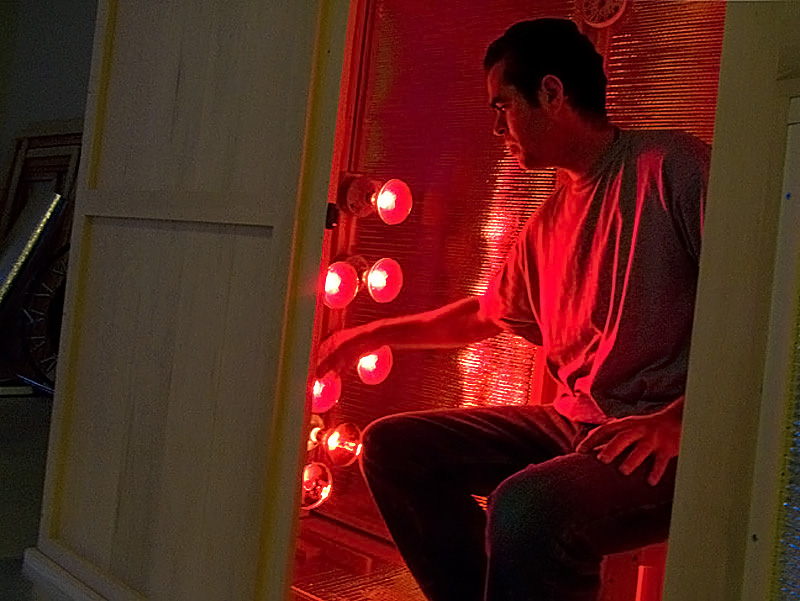 Michael Goldstein sits inside a partially completed near infrared sauna he built at the Searsport workshop of his one-man company Long Life Saunas. (Photo by Ethan Andrews)
Michael Goldstein sits inside a partially completed near infrared sauna he built at the Searsport workshop of his one-man company Long Life Saunas. (Photo by Ethan Andrews)
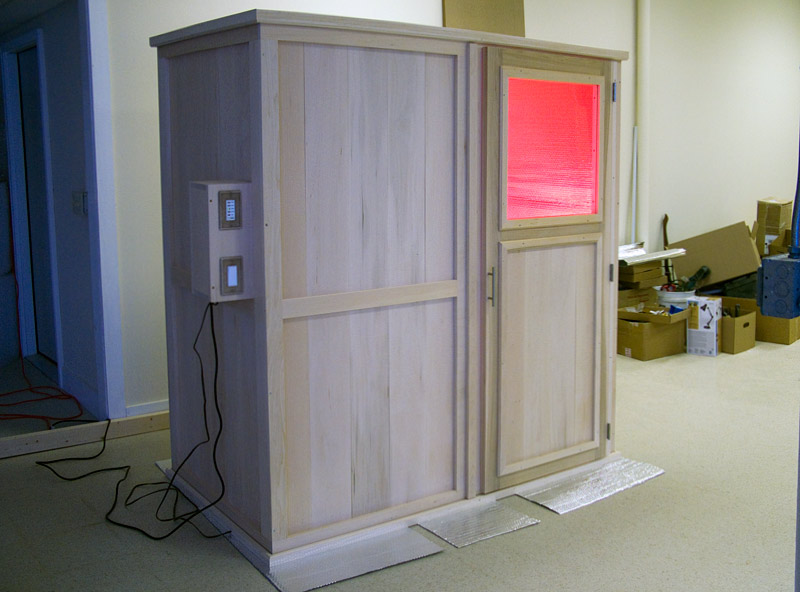 The glow of near infrared bulbs can be seen through the window of Goldstein's newest sauna, which was undergoing some finishing touches at his Searsport workshop. (Photo by Ethan Andrews)
The glow of near infrared bulbs can be seen through the window of Goldstein's newest sauna, which was undergoing some finishing touches at his Searsport workshop. (Photo by Ethan Andrews)
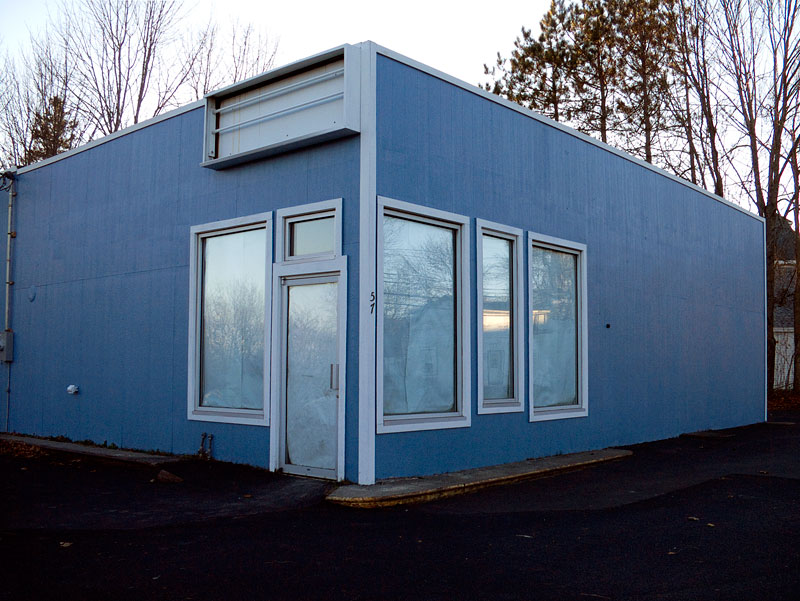 The headquarters of Long Life Saunas, located in a former convenience store in downtown Searsport. (Photo by Ethan Andrews)
The headquarters of Long Life Saunas, located in a former convenience store in downtown Searsport. (Photo by Ethan Andrews)
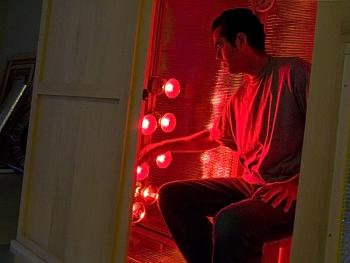 Michael Goldstein sits inside a partially completed near infrared sauna he built at the Searsport workshop of his one-man company Long Life Saunas. (Photo by Ethan Andrews)
Michael Goldstein sits inside a partially completed near infrared sauna he built at the Searsport workshop of his one-man company Long Life Saunas. (Photo by Ethan Andrews)
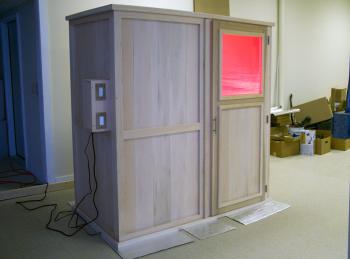 The glow of near infrared bulbs can be seen through the window of Goldstein's newest sauna, which was undergoing some finishing touches at his Searsport workshop. (Photo by Ethan Andrews)
The glow of near infrared bulbs can be seen through the window of Goldstein's newest sauna, which was undergoing some finishing touches at his Searsport workshop. (Photo by Ethan Andrews)
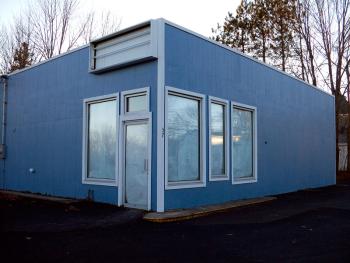 The headquarters of Long Life Saunas, located in a former convenience store in downtown Searsport. (Photo by Ethan Andrews)
The headquarters of Long Life Saunas, located in a former convenience store in downtown Searsport. (Photo by Ethan Andrews)
SEARSPORT - At first blush, Michael Goldstein's near infrared saunas bring to mind Wilhelm Reich's Orgone energy accumulators of the 1940s and 1950s. Both are essentially foil-lined boxes designed to focus life-giving energy on the person sitting inside. Neither is widely recognized — though the therapeutic use of near infrared is fairly recent by comparison. And both have been tested outside of medical settings for the treatment of cancer and other severe ailments.
But where Reich's ideas failed on the shakiness of his claims about the omnipresent life-force he dubbed "Orgone" (his cause among scientists wasn't helped by rumors that the accumulators induced a heightened state of sexual potency), Goldstein's near infrared saunas, while not as mysterious or sexy, at least have some basic science on their side.
And as he's quick to point out, he didn't come up with the idea, he simply refined it.
Goldstein's background is in nutrition. He first learned of near infrared therapy while working with Dr. Larry Wilson in Arizona. At the time, the use of infrared light was popular but only the far infrared end of the spectrum. Wilson saw near-infrared light, named for being closer to the visible spectrum, as having additional benefits over far infrared and fewer, if any, risks.
The concept at the core of both near and far infrared therapy is the basic sauna, in which sweat acts as a vehicle for drawing out heavy metals and other toxins. A temporary increase in body temperature is also thought to have health benefits.
None of this is new. The part that might raise eyebrows is the claim that near infrared light has additional benefits. Goldstein seems to anticipate these questions on his website and devotes a separate page solely to the science behind his products, citing research from no less estimable a source than NASA.
The space administration's research found that human cells have receptors designed to respond specifically to near infrared wavelengths. The high frequency light penetrates deep into the body triggering growth and regeneration of cells. It also promotes antioxidant activity, and reduces inflammation and pain.
By contrast, Goldstein said, far infrared light, which is invisible, simply makes the body hot, which is fine for a sauna effect, but the benefit stops there. Far infrared also creates a large electromagnetic field.
"When health conscious people see 'High EMF','" he said, "they run."
After working with Wilson, Goldstein stepped away from medicine for several years and took a job in a high volume wood shop. The move wasn't part of a specific plan, but it was at this apparently unrelated job that he learned the cabinetry skills he would later use to refine Dr. Wilson's basic sauna design, which was constructed of PVC piping and canvas, into something that looks less like a tent and more like a traditional sauna.
Goldstein built his first near infrared sauna in 2004 and said the benefits were transformative. In conversation, the word he uses is "awesome."
In an account on his website, he says he experienced total relief from back pain, clear skin, clear thinking, lowered blood pressure and more energy on a daily basis. He also claims the process detoxified his body of mercury and copper. In 2009 he started his own business, Long Life Saunas. A year later, he had enough orders to make it his full-time occupation. Today he remains a one-man business but said he finds himself struggling to keep up with demand.
Several months ago he moved to Belfast from a town in Vermont and quickly set up his woodshop and business headquarters in a former convenience store in downtown Searsport.
On a day in late November, he was putting the finishing touches on a deluxe model sauna for a customer in Boca Raton — a retired dentist with leukemia who liked the sauna Goldstein built for his home in Connecticut so much that he ordered another one for his second home in Florida.
Goldstein said about half of his customers are chronically ill, and half of those suffer from some form of cancer.
The model in his shop was built of ship-lapped basswood and finished with a simple trim. It was not conspicuously fancy, but was among the most labor-intensive versions Goldstein has made. The price tag, he said, would be around $3,600, plus shipping — an additional cost he's tried to make more manageable by building the saunas in modular sections that can be collapsed and stacked flat.
Asked how many others in the country are making near infrared saunas, Goldstein guessed maybe five.
"In terms of a product like this?" he asked.
He turned to the furniture-grade sauna behind him for a moment before answering his own question.
"Me," he said.
Goldstein didn't set out to make high-end products. His modest goal at the outset was to make his mentor's design a little more handsome, and he's enough of a believer that he's often taught people to make their own saunas if it meant the difference between their using near infrared or not.
His products range from banks of near infrared lights that can be used for quick and dirty closet conversions, to a $1,200 kit that uses an open-sided wooden frame covered only in the foil-like reflective material.
"That's my contribution to the sauna field," he said, speaking of his use of the silver bubble wrap-like material sold under the trade name Reflectix. The comment, delivered with a hint of irony, suggested that he probably did come up with the idea first, but saw it more as an obvious improvement than an innovation. Regardless, the foil-like material bounces the light around in a way that directs more of it at the skin.
The warmth inside a near infrared sauna feels a lot like sunlight, in part, Goldstein said, because around a third of sunlight comes from the infrared end of the spectrum. There's also a strong directional effect that comes from the placement of the reflector lamps on one end of the wardrobe-sized box. During a session, a user sitting on a wooden stool might rotate a quarter turn at regular intervals to expose the whole body, or focus the light on one location in the case of trying to treat a tumor in a particular place, Goldstein said.
The bulbs themselves look like the kind of heat lamps you'd see above a fast food buffet. Asked if they're similar, Goldstein took the question in stride. They're in the same range of the spectrum, he said. Unlike far infrared, which is invisible, near infrared light would show off the food to good effect.
"It's not as appealing to the eye if your french fries are in a dark container," he said.
On the topic of french fries, one of the most common questions Goldstein gets from potential customers is whether the near infrared light will give them a tan or cause skin problems associated with ultraviolet light.
It won't, he said, adding that it's also not harmful to look at except to the extent that it's very bright.
During one 20-minute sauna, Goldstein said, the body is exposed to about the same amount of near infrared light as in a session of sunbathing or a day spent working outdoors.
That's some of the science. But like any therapy that hasn't been widely embraced, Goldstein acknowledged that there are some nutty ideas about the additional benefits a person can derive from using a near infrared sauna. He knows a few of them, he said, but for now he's keeping them to himself.
There's enough science to support the benefits of near infrared, he said. Beyond that, it's common sense.
"Everybody understands a sauna," he said. "It's hot, you sweat and it's relaxing. That's not nutty."
Event Date
Address
57 East Main Street
Searsport, ME 04974
United States
















